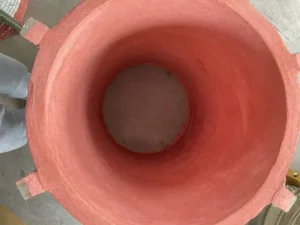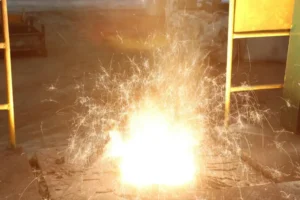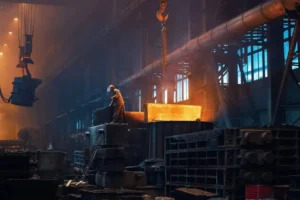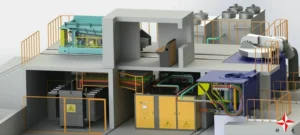Induction melting technology, with its unique advantages, is revolutionizing the traditional metal melting and casting industries. It not only efficiently melts various metals but also plays an indispensable role in improving product quality and optimizing production processes. This article will delve into the application of induction furnaces in melting different metals and reveal how innovations in induction melting can boost efficiency and product quality.
I. Principles and Key Advantages of Induction Melting
Induction melting uses the principle of electromagnetic induction. An alternating magnetic field generates eddy currents within conductive materials (metals), causing the metal itself to heat up and melt. Its core advantages include:
- High Efficiency and Energy Saving: Electrical energy is directly converted into heat, resulting in high thermal efficiency and minimal energy loss.
- Clean and Environmentally Friendly: No flames or smoke, reducing environmental pollution and improving the working environment.
- Precise Temperature Control: Easy to achieve accurate temperature control, which is beneficial for precise alloying.
- Stirring Effect: The electromagnetic forces in the melt pool create a stirring action, making the alloy components more uniform.
- Fast Start-up and Shut-down: Compared to traditional furnaces, induction furnaces heat up quickly and allow for flexible start-up and shut-down.
- Operational Flexibility: Easy to change furnace linings, allowing for quick switching between melting different metals.
II. Applications of Induction Furnaces in Melting Various Metals
Due to their strong adaptability, induction furnaces are widely used in the melting and casting of various metals, optimized for each metal’s specific characteristics.
1. Steel Melting and Casting
Steel is the backbone of modern industry, and induction furnaces play a crucial role in its melting.
- Scrap Steel Melting: Induction furnaces are ideal for melting scrap steel. Their efficient melting capabilities and precise composition control help produce high-quality recycled steel. Medium-frequency induction furnaces are most commonly used in this area.
- Alloy Steel Production: They allow for precise control over the addition of alloying elements and melt pool temperature, ensuring uniform chemical composition and stable mechanical properties for alloy steels. This includes the production of stainless steel, tool steel, and high-speed steel.
- Vacuum Induction Melting (VIM): For special steel grades requiring extremely high purity, low gas content, or containing volatile elements (such as superalloys, precision alloys), vacuum induction furnaces provide a vacuum or inert atmosphere to effectively remove harmful impurities and gases.
- Lining Selection: Acidic (hal., silicon dioxide) or basic (hal., magnesium oxide, aluminum oxide) linings are typically used for melting steel, chosen based on the steel grade and impurity removal requirements.
2. Aluminum Melting and Casting
Aluminum and its alloys are widely used due to their lightweight and corrosion resistance. Induction furnaces offer unique advantages in aluminum melting.
- Fast Melting: Aluminum has a relatively low melting point, and induction furnaces can melt it quickly, reducing melting time.
- Reduced Oxidation: Compared to gas-fired furnaces, flameless induction heating effectively reduces oxidation loss of molten aluminum, minimizing burn-off.
- Precise Temperature Control: Helps prevent overheating and reduces hydrogen absorption, thereby lowering the risk of porosity in castings.
- Holding Function: Induction furnaces can also serve as holding furnaces, maintaining the molten aluminum’s temperature for subsequent die-casting or gravity casting.
- Lining Selection: Neutral or weakly acidic linings are typically used for melting aluminum.
3. Copper Melting and Casting
Copper and its alloys are excellent electrical and thermal conductors. Induction furnaces also perform exceptionally well in melting copper and copper alloys.
- High-Efficiency Melting: Copper has high electrical conductivity, making induction heating highly efficient, allowing for rapid melting of copper scrap or refined copper.
- Uniform Composition: The electromagnetic stirring action ensures uniform composition of copper alloys, improving casting quality.
- Reduced Gas Absorption: Precise temperature control and a controllable atmosphere help reduce oxygen and hydrogen content in molten copper, lowering casting defects.
- Continuous Casting of Copper Rods and Tubes: Induction melting technology plays a crucial role in continuous casting lines for copper and copper alloys, ensuring a stable and continuous supply of molten metal.
- Lining Selection: Neutral or acidic linings are typically used for melting copper.
4. Precious Metal Melting and Casting
Gold, pilak na pilak, platinum, and other precious metals require extremely high standards for the melting process due to their value and unique properties.
- Purity Assurance: The clean melting environment of induction furnaces avoids contamination from traditional fuel combustion, maximizing the purity of precious metals.
- Minimal Loss: Precise temperature control and no crucible contamination risk significantly reduce precious metal burn-off and contamination.
- Fast and Efficient: Especially suitable for rapid melting and casting of small batches of high-value precious metals.
- Vacuum or Atmosphere Protection: For certain precious metal alloys requiring special atmosphere protection, induction furnaces can provide a vacuum or inert atmosphere.
- Lining Selection: Graphite crucibles or high-purity ceramic crucibles are typically used to ensure the purity of precious metals.
III. Key Strategies to Boost Melting Efficiency and Product Quality
To fully leverage the advantages of induction melting, a comprehensive approach using the following strategies is necessary:
1. Optimize Equipment Selection and Configuration
- Match Frequency and Power: Choose the appropriate medium-frequency, high-frequency, or line-frequency induction furnace based on the type of metal, melting capacity, and melting speed requirements.
- Advanced Power Supply Technology: Adopt new power supply technologies like IGBTs to improve power supply efficiency and stability.
- Automation and Intelligence: Introduce automated charging, temperature control, and pouring systems to reduce manual intervention and enhance production consistency.
- Efficient Cooling System: Ensure effective cooling of the furnace body, induction coils, and power supply to extend equipment life and improve operational stability.
2. Precise Process Control
- Accurate Temperature Control: Utilize infrared thermometers, thermocouples, atbp., combined with PID (Proportional-Integral-Derivative) controllers, to achieve precise control over the melt pool temperature.
- Atmosphere Protection: For easily oxidized or gas-absorbing metals, introduce inert gases (tulad ng argon, nitrogen) or conduct vacuum melting to effectively prevent oxidation and gas contamination.
- Composition Optimization and Analysis: Use rapid analysis equipment like spectrometers to monitor and adjust alloy composition in real-time, ensuring products meet design specifications.
- Slag Treatment and Degassing: Employ appropriate slag removal and degassing processes (such as argon bubbling, vacuum treatment) to remove inclusions and harmful gases from the molten metal.
- Stirring Control: Appropriately control the stirring intensity of the induction furnace to ensure uniform distribution of alloy elements while avoiding excessive stirring that could lead to gas entrainment.
3. Charge Material Management and Pre-treatment
- Clean Charge Material: Ensure scrap is clean, free of oil, and impurities to reduce contamination and smoke during melting.
- Charge Material Preheating: Preheating cold charge material can significantly shorten melting time, reduce energy consumption, and minimize thermal stress that might occur when cold material is added to the melt pool.
- Accurate Proportioning: Precisely calculate the charge material ratios based on the target composition to reduce the need for subsequent adjustments.
4. Lining Selection and Maintenance
- Choose Appropriate Lining Materials: Select refractory, corrosion-resistant, and thermal-shock-resistant lining materials based on the properties of the metal being melted (acidic, basic, or neutral) and the melting temperature.
- Lining Construction and Sintering: Strictly follow specifications for lining construction and sintering to ensure the lining’s density and strength.
- Regular Maintenance and Inspection: Regularly check for lining wear, and promptly repair or replace it to prevent lining penetration accidents.
Konklusyon
Induction melting and casting technology, with its efficiency, cleanliness, and precision, has brought revolutionary changes to the modern metal processing industry. By deeply understanding its principles, applications in different metals, and continuously optimizing equipment, Mga proseso, and management, businesses can significantly improve melting efficiency and produce higher-quality metal products, thus gaining a competitive edge in the market. In the future, with the further development of intelligent and automated technologies, induction melting is bound to play an even more crucial role in the metal industry.







